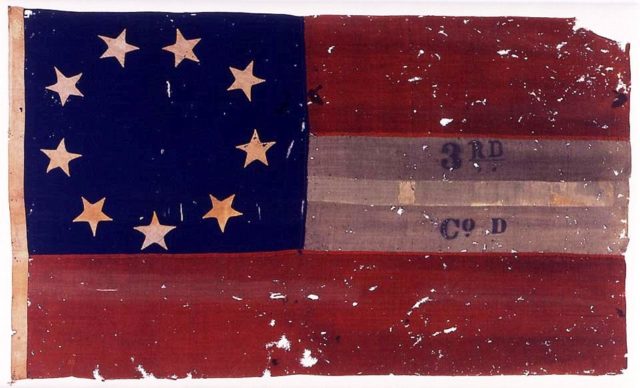The state rights tone was set in the preamble to the Confederate Constitution in the significant phrase, “each State acting in its sovereign and independent character.”
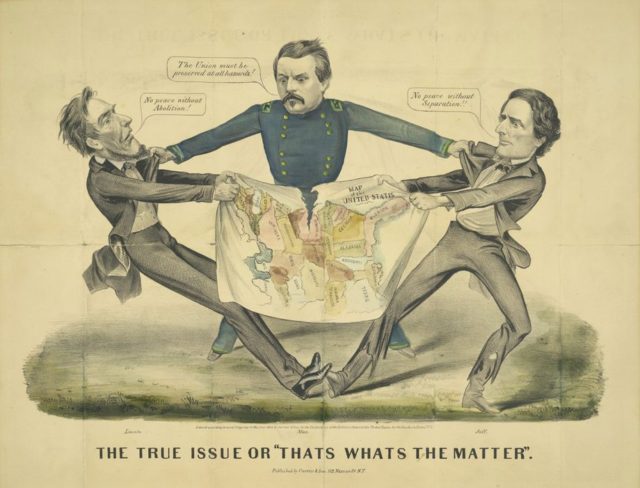 Secession was based on the idea of state rights (or “states rights,” a variant that came into use after the Civil War). This exalted the powers of the individual states as opposed to those of the Federal government. It generally rested on the theory of state sovereignty– that in the United States the ultimate source of political authority lay in the separate states. Associated with the principle of state rights was a sense of state loyalty that could prevail over a feeling of national patriotism. Before the war, the principle found expression in different ways at different times, in the North as well as in the South. During the war it reappeared in the Confederacy.
Secession was based on the idea of state rights (or “states rights,” a variant that came into use after the Civil War). This exalted the powers of the individual states as opposed to those of the Federal government. It generally rested on the theory of state sovereignty– that in the United States the ultimate source of political authority lay in the separate states. Associated with the principle of state rights was a sense of state loyalty that could prevail over a feeling of national patriotism. Before the war, the principle found expression in different ways at different times, in the North as well as in the South. During the war it reappeared in the Confederacy.
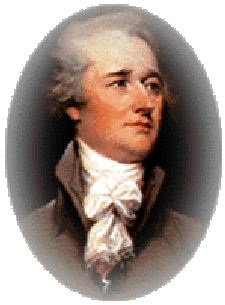
Alexander Hamilton
Hamiltonians and Jeffersonians
The Constitution could be interpreted in opposite ways. In its clause giving Congress all powers “necessary and proper” for carrying the specified powers into effect, Alexander Hamilton as secretary of the treasury found ample authorization for his financial program, including a national bank. In the Tenth Amendment, however, Thomas Jefferson as secretary of state discovered a bar to congressional legislation of that kind: no power to establish a bank having been delegated to Congress, that power must have been reserved to the states. As president, George Washington sided with Hamilton and signed the bills that Congress passed to enact Hamilton’s plan. Eventually Jefferson withdrew from the Washington administration and, with Madison, organized an opposition to it. Thus, in the 1790s, originated the two parties, Federalist and Republican, the one willing to exploit the “implied powers” of the Constitution, the other demanding a “strict construction” of the document.
The Republicans already convinced that much of the Federalist legislation was unconstitutional, were further outraged when, in 1798, Congress passed the Alien and Sedition Acts. The Sedition Act–providing for the fining and imprisoning of those who uttered anything “false, scandalous, and malicious” against the government, the Congress, or the president–seemed flagrantly to violate the First Amendment, which stated that Congress should pass no law abridging freedom of speech or of the press.
What agency should decide the question of constitutionality? The Constitution did nor, in so many words, give the Supreme Court the power to decide, and the Republicans denied that the Court could rightfully assume the power. Their leaders, Jefferson and Madison, arguing that the state legislatures should decide, ably expounded their views in two sets of resolutions, one written (anonymously) by Jefferson and adopted by the Kentucky legislature (1798-1799) and the other drafted by Madison and approved by the Virginia legislature (1798).
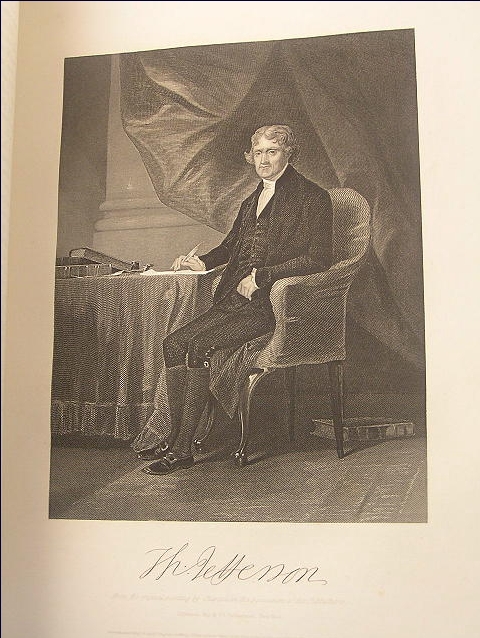
Thomas Jefferson
These Kentucky and Virginia Resolutions asserted the following propositions: The Federal government bad been formed by a “compact” or contract among the states. It was a limited government, possessing only specific delegated powers. Whenever it attempted to exercise any additional, undelegated powers, its acts were “unauthoritative, void, and of no force.” The parties to the contract, the states, must decide for themselves when and whether the central government exceeded its powers. The state legislatures must serve as “sentinels” to watch out for unconstitutional acts. And “nullification” by the states was the “rightful remedy” whenever the general government went too far. The resolutions urged all the states to join in declaring the Alien and Sedition Acts null and void and in demanding their repeal at the next session of Congress, but none of the other states went along with Virginia and Kentucky.
State rights and strict construction were usually the arguments of the party out of power (and so they were to he throughout American history). As long as the Republicans were outsiders, they remained strict constructionists, hut once they had become insiders, with Jefferson as president, they used the full powers of the Federal government to further the agrarian interests they represented. Indeed, they used much more than the rightful and constitutional powers, according to the Federalists, who now adopted the state rights point of view.
The Jefferson administration bought Louisiana from France in 1803 even though the Constitution gave Congress no explicit power to acquire new territory. On the constitutionality of the purchase Jefferson himself had serious doubts hut managed to overcome them. The administration also imposed an embargo in 1807 forbidding American ships to leave American ports, though the Constitution allowed Congress only to regulate interstate and foreign commerce, not to prohibit it. In anger against the Louisiana Purchase, a few extreme Federalists, the Essex Junto, conspired to bring about the secession of New England. In condemning the embargo, a much larger number resorted to the doctrine of state rights. The young New Hampshire Federalist Daniel Webster, for one, paraphrased the Virginia and Kentucky Resolutions: “The Government of the United States is a delegated, limited Government.”

James MAdison
During the presidency of Jefferson’s friend and successor James Madison, the New England state rights men gained their largest following in opposition to the War of 1812. In Congress, Webster attacked and helped defeat a conscription bill. “The operation of measures thus unconstitutional and illegal ought to be prevented by a resort to other measures which are both constitutional and legal,” he declared, hinting at nullification by New Hampshire. “It will be the solemn duty of the state governments to protect their own authority over their own militia and to interpose between their citizens and arbitrary power” In fact, some of the New England states, by refusing to support the war, virtually nullified the war effort of the Federal government. New England state-rightism and sectionalism reached a climax in the Hartford Convention (1814-1815), which demanded changes in the Constitution and threatened secession if they were not made.
Some of Jefferson’s followers had turned against him when, as they saw it, he departed from his own principles. His distant cousin and (before 1804) House leader John Randolph of Roanoke organized within the Republican party a state rights faction known as the Quids. Randolph remained a fanatical defender of Virginia rights. John Taylor of Caroline, an equally consistent but more original thinker than Randolph, led the Virginia School, which included St. George Tucker and Spencer Roane. These men rationalized resistance to the centralizing trend, especially to the work of the Supreme Court under Virginian John Marshall. Jefferson, after his retirement from the presidency, joined in opposing the Federalist-minded judges as “sappers and miners” who were undermining the Constitution. The Georgia state rights men, whose leader was William H. Crawford, had their own quarrel with Marshall, who ruled against them when the state undertook to evict its Indians from their tribal lands.
Calhoun’s Contribution
John C. Calhoun was a latecomer to the state rights cause, but he developed the theory more fully than anyone else. In Congress he had favored the War of 1812 and had advocated protective tariffs, internal improvements at Federal expense, and a national bank. By 1828 he was convinced that a protective tariff was not only harmful to his state, South Carolina, but was also contrary to the Constitution. He then began to work out his system for state resistance to unconstitutional laws.

John C. Calhoun
Calhoun refined and elaborated the doctrine of sentinelship that Madison and Jefferson had presented in the Virginia and Kentucky Resolutions. He based his theory on the assumption that the people (not the government) in each state were sovereign and, in their sovereign capacity, had ratified and thus given validity to both the state constitution and the U.S. Constitution. They had done so, he argued, through their delegates in specially elected conventions. In this ratification process he discovered the procedure for dealing with questions of constitutionality. A state convention–not the state legislature as in Madison’s and Jefferson’s proposal could nullify a Federal law. That law would remain null and void within the state until three-fourths of all the states had ratified a constitutional amendment specifically giving Congress the power in question. If they should ever do so, the nullifying state would still have a recourse secession. Just as a state could “accede” to the Union by ratifying the Constitution, it could “secede” by repealing its ordinance of ratification.
South Carolina put nullification to the test in 1832, when a state convention declared all protective tariffs, particularly those of 1828 and 1832, to be null and void within the state. Calhoun having resigned the vice presidency, the nullifiers sent him to the Senate to present their case. Debating him was Daniel Webster, now a senator from Massachusetts, who had switched from a state rights position to a nationalist one while Calhoun was doing the reverse. “The truth is,” Webster contended, “and no ingenuity of argument, no subtlety of distinction, can evade it, that, as to certain purposes, the people of the United States are one people.” According to the new Webster, a state might secede from the Union, but only on the basis of the right of revolution, not on the basis of any constitutional right. While remaining in the Union, however, a state could not nullify congressional acts, for nullification was no right at all, he maintained.

President Andrew Jackson
President Andrew Jackson, agreeing with Webster, denounced nullification as treason and asked Congress for authority to use the army and the navy to enforce the laws. Though the nullificationists had sympathizers in other Southern states, not one of those states officially endorsed the South Carolina stand. Calhoun claimed a victory for nullification when Congress passed and Jackson signed a compromise bill for gradually lowering the tariff But nullification had not really worked the way Calhoun had intended. It had not been generally accepted as a legitimate and constitutional procedure. Calhoun came to realize that a single state, unaided, was powerless to interpose against Federal authority. So he set about cultivating a spirit of unity among all the slave states.
Slavery, according to Calhoun, occupied a special place in the Constitution, and certainly it occupied a special place in his theory of state rights. It was, he insisted, the only kind of property that the Constitution specifically recognized (though, in fact, the document did not mention slaves or slavery by name; it referred only to “free Persons” and “all other Persons” and to a “Person held to Service or Labour“). Therefore, nullification could be used to defend or strengthen slavery but not to attack or weaken it. Calhoun strenuously objected when, after 1842, several free states tried their own brand of nullification by adopting “personal liberty” laws that forbade state authorities to assist in the enforcement of the Federal Fugitive Slave Act of 1793.
Calhoun was farther outraged when the House, though not the Senate, passed the Wilmot Proviso in 1848, which aimed to exclude slavery from all territories to be acquired in consequence of the Mexican War. Then, when the Compromise of 1850 proposed to admit California as a free state and thus to upset the balance of free and slave states, he thought the time had come for the slave states to resort to their ultimate redress, secession.
Taney and the Territories
During the 1850s the doctrine of state rights became a dogma of stare powers–powers that extended beyond the boundaries of the states themselves. The development of this dogma was occasioned by the question of slavery in the territories.
Many Northerners held that Congress could exclude slavery, as it had done with respect to the Northwest Territory in the Northwest Ordinance (1787, 1789) and with respect to part of the Louisiana Purchase in the Missouri Compromise (1820-1821). Some advocated “popular sovereignty,” or “squatter sovereignty,” which would allow the settlers themselves to decide whether to permit slavery in a particular territory, and this principle was embodied in the Kansas-Nebraska Act of 1854. But proslavery Southerners insisted that any prohibition of slavery in a territory, whether by Congress or by the local people, was unconstitutional.
From the proslavery point of view, the sovereign stares had delegated to Congress only the power to make routine “rules and regulations” for the territories, not the power to make basic policies for them. When dealing with the subject, the Federal government must act merely as a trustee for the states and must give effect to their laws, particularly the laws respecting slavery State rights was no longer just a defense of local self-determination; it had become a means of imposing a states laws on people outside the state.
The theory now called for an enlargement rather than a reduction of Federal authority, at least in regard to the territories, though this authority could be exercised only to protect slavery. As President Franklin Pierce said in 1855, the Federal government was “forbidden to touch this matter in the sense of attack or offense” and could do so only “in the sense of defense.” Proslavery advocates looked to the Supreme Court for an endorsement of their new theory of state sovereignty. The Court obliged in the Dred Scott case (1857) with an obiter dictum declaring unconstitutional the Missouri Compromise prohibition of slavery in part of the Louisiana Purchase. Chief Justice Roger B. Taney said: “The Government of the United States had no right to interfere for any other purpose but that of protecting the rights of the [slave] owner.”
For the time being, the strongest assertion of state rights in defiance of Federal authority came not from any Southern state hut from Wisconsin, which invoked the doctrine to oppose slavery rather than to support it. When a Federal court convicted Sherman Booth of violating the Fugitive Slave Act of 1850, the Wisconsin Supreme Court repeatedly (1854-1855) issued Writs of habeas corpus to release him on the ground that the act was unconstitutional. Booth and fellow antislavery radicals made state rights a test of orthodoxy in the newly formed Republican party; they demanded that the party’s candidates endorse the principles of the Virginia and Kentucky Resolutions of 1798 and 1799. In the case of Ableman v. Booth (1859) Taney and the Supreme Court again upheld the Southern as opposed to the Northern state rights position. They overruled the supreme court of Wisconsin.
The Wisconsin governor then reasserted the sovereignty of his state. As commander in chief of the state militia, he challenged the president as commander in chief of the U.S. Army and Navy. “It is reported,” a Wisconsin official notified the captain of one of the militia companies, “... that you have stated that, in the possible contingency of a conflict between the U.S. authorities and those of this State, you . . . would obey a call for your company to turn out, made by the U.S. authorities, but would not obey a call by your superior officials under the State laws.” When the captain replied that he would consider it treason to disobey a presidential order, the governor dismissed him and disbanded his company. That was in 1860, only months before South Carolina began the secession of the Southern states.
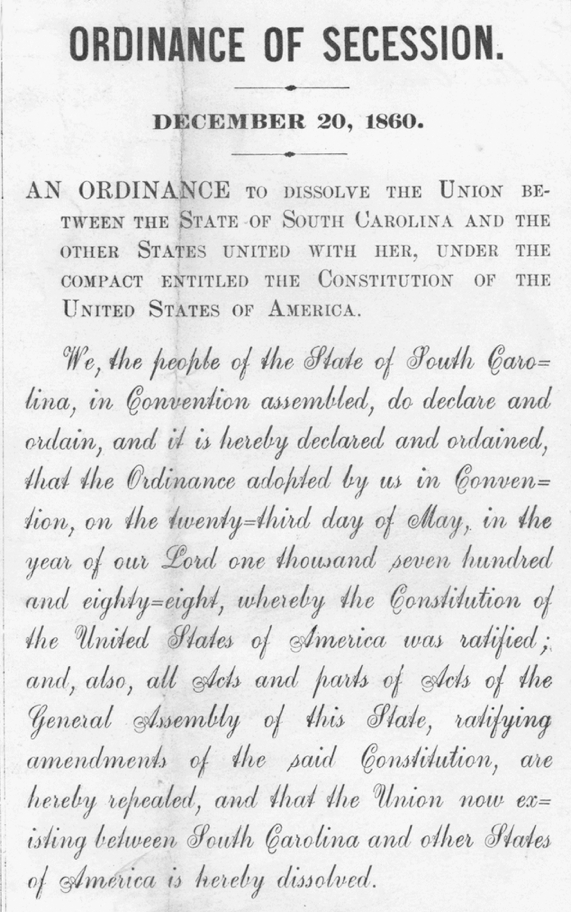 Secession and the Confederate Constitution
Secession and the Confederate Constitution
Some advocates of secession justified it as a revolutionary right, but most of them based it on constitutional grounds. The 1860 South Carolina Declaration of the Causes of Secession quoted the states 1852 declaration, which said that “the frequent violations of the Constitution of the United States by the Federal Government, and its encroachments upon the reserved rights of the States,” would justify the state in withdrawing from the Union. The South Carolina secession ordinance, following the procedure that Calhoun had prescribed, simply repealed the states ratification of the Constitution and subsequent amendments. The secession ordinances of other states did the same.
The Constitution of the Confederate States of America proved to he somewhat inconsistent in regard to state rights. It contained no provision for secession, though its preamble averred that each Confederate state was “acting in its sovereign and independent character.” One article (like the Tenth Amendment of the U.S. Constitution) affirmed that the “powers not delegated” were “reserved to the States.” The states, however, were limited in important ways. For example, they could not (just as the states of the Union could not) pass any law “impairing the obligation of contracts.” They could not get rid of slavery, for the citizens of each state were to “have the right of transit and sojourn in any State . . . with their slaves.”
 Congress was forbidden to impose duties or taxes to promote or foster any branch of industry but in some ways was given even greater powers than the U.S. Congress. The ambiguity regarding territories and slavery was removed. The Confederacy could “acquire new territory,” and Congress could “legislate” (nor merely make “rules and regulations“) for the territories. In all of them “the institution of negro slavery” was to be “recognized and protected by Congress and by the territorial government.” Congress could make all laws necessary and proper” for carrying out its specified powers. If this or any other clause should lead to a dispute over the constitutionality of a law, the Confederate courts (rather than state legislatures or conventions) would presumably decide the issue. This was implied by the following provision: “The judicial power shall extend to all cases arising under the Constitution.”
Congress was forbidden to impose duties or taxes to promote or foster any branch of industry but in some ways was given even greater powers than the U.S. Congress. The ambiguity regarding territories and slavery was removed. The Confederacy could “acquire new territory,” and Congress could “legislate” (nor merely make “rules and regulations“) for the territories. In all of them “the institution of negro slavery” was to be “recognized and protected by Congress and by the territorial government.” Congress could make all laws necessary and proper” for carrying out its specified powers. If this or any other clause should lead to a dispute over the constitutionality of a law, the Confederate courts (rather than state legislatures or conventions) would presumably decide the issue. This was implied by the following provision: “The judicial power shall extend to all cases arising under the Constitution.”
In sum, the new Constitution was more national than the old one with regard to slavery, which it guaranteed as a nationwide institution. The document provided no more basis for nullification or secession than its predecessor had done–despite the preambles reference to the member states as “sovereign” and “independent.” Nevertheless, there remained room for the reassertion of state rights in the Confederacy.
State Rights in the Confederacy
To win its independence, the Confederacy needed a government strong enough to make the most of all the available human and material resources, but some of the state leaders were no more willing to concede power to the Confederate government than they had been to the Federal government. Appealing to the principle of state rights, they resisted the efforts of the 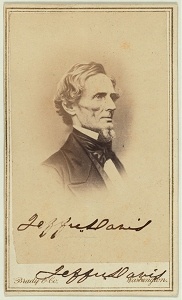 Jefferson Davis administration to control blockade running and manufacturing, to impress slaves and other property, and even to raise troops. Georgia was the locus of the greatest recalcitrance, Joseph B. Brown the most obstreperous of the governors, and Vice President Alexander H. Stephens the busiest fomenter and philosopher of resistance. North Carolina, under Governor Zebulon Vance, was the next most important center of obstructionism, but practically all the states had some occasion for expressing opposition to Confederate measures.
Jefferson Davis administration to control blockade running and manufacturing, to impress slaves and other property, and even to raise troops. Georgia was the locus of the greatest recalcitrance, Joseph B. Brown the most obstreperous of the governors, and Vice President Alexander H. Stephens the busiest fomenter and philosopher of resistance. North Carolina, under Governor Zebulon Vance, was the next most important center of obstructionism, but practically all the states had some occasion for expressing opposition to Confederate measures.
The most serious question was the constitutionality of the conscription acts (April/September 1862, and February 1864). Davis justified the legislation on the basis of the constitutional clause giving Congress the power to raise and support armies. But Brown and Stephens argued that the Confederate government could raise troops only by making requisitions upon the stares, which alone, they said, had the constitutional power to impose a draft. Stephens declared: “The citizen of the State owes no allegiance to the Confederate States Government.. . and can owe no ‘military service to it except as required by his own State.” Brown protested to Davis that conscription was a “hold and dangerous usurpation by Congress of the reserved rights of the States.”
To enforce conscription, Congress authorized the president to suspend the privilege of the writ of habeas corpus. To Stephens, this seemed as bad as conscription itself He denounced the suspension in resolutions, which the Georgia legislature passed and which, along with speeches by Brown and Stephens’s half-brother Linton Stephens, were printed and widely circulated. The legislatures of North Carolina and Mississippi adopted similar resolutions.
The question of constitutionality could not be referred to a Confederate supreme court, for there was none. In 1861 the Provisional Congress provided for such a court, with the power of judicial review, but the permanent Congress established only a system of lower tribunals. When Congress considered adding a supreme court in 1863, opponents objected to the potential subordination of the state supreme courts. These consequently were left to go on deciding the constitutionality of both state and Confederate laws. The Supreme Court in Georgia and in every other state except North Carolina upheld the Confederate conscription acts. “When Congress calls for the military service of the citizen,” the Texas judges ruled, ” … the right of the State government must cease or yield to the paramount demand of Congress.”
Despite the pro-Confederate decisions of state courts, conflicts between the Confederate government and the state governments persisted. Texas objected to giving up control of state troops, as did Alabama, Mississippi, and all the Gulf states except Florida. A Florida judge, however, issued an injunction against Confederate officers who were ordered to take up some of the track of the Florida Railroad – and who disregarded the injunction.
More serious obstruction came from North Carolina, where Governor Vance took pains to “preserve the rights and honor of the State.” He said it was “mortifying” to see North Carolinians “commanded by strangers” – that is, by men from other states – and he demanded that their officers be North Carolinians. Operating a state-owned blockade-runner, Advance, he objected to the Confederacy’s claim to half of the cargo space. He warehoused uniforms, shoes, and blankets for the exclusive use of North Carolina troops at a time when Robert E. Lees’ army in Virginia was suffering from the want of such supplies. State officials being exempt from the draft, he appointed thousands of men to state jobs to keep them out of the Confederate army.
Governor Brown of Georgia went even further in making unnecessary state appointments. Then, after enrolling ten thousand militiamen, he refused to allow them to enter the Confederate service even when in 1864 Davis attempted to requisition them – as Brown had previously said the president had a right to do. Brown now insisted he was protecting his state against both “external assaults and internal usurpations.” The Confederate secretary of war compared him to the New England governors who had resisted the war effort during the War of 1812. Brown rejected the Richmond authorities references to “refractory Governors” and “loyal States.” Such remarks were “utterly at variance with the principles upon which we entered into this contest in 1861,” he said. The Confederate government was “the agent or creature of the States,” and its officers had no business “discussing the loyalty and disloyalty of the sovereign States to their central agent – the loyalty of the creator to the creature.”
The right of secession followed logically from such Calhounian doctrine. Vance, however, would not hear of it when disaffected North Carolinians talked of calling a secession convention in 1863. Brown and Stephens declined when, after taking Atlanta, Gen. William Tecumseh Sherman proposed a meeting to discuss Georgia’s leaving the Confederacy and making a separate peace. But Stephens wrote privately: “Should any State at any time become satisfied that the war is not waged for purposes securing her best interests…. she has a perfect right to withdraw.” By early 1865, at least one Georgia planter had come to suspect that Stephens and his associates were plotting to “withdraw if possible this and two other States from the Confederacy and set up for themselves.”
In fact, none of the states ever came close to seceding from the Confederacy, and most of them avoided an extreme state rights position all along. Nevertheless Davis had ample cause for complaint. In a private letter of December 15, 1864, he wrote that his difficulties had been “materially increased by the persistent interference of some of the State Authorities, Legislative, Executive, and Judicial, hindering the action of the Government, obstructing the execution of its laws denouncing its necessary policy, impairing its hold upon the confidence of the people, and dealing with it rather as if it were the public enemy than the Government which they themselves had established for the common defense, and which was the only hope of safety from the untold horrors of Yankee despotism.”
Historians have differed about the importance of state rights as a cause of Confederate defeat. One writer has gone so far as to suggest that the following words should be engraved on the Confederacy’s tombstone: “Died of State Rights.”
Others minimize its effects, pointing out that it was a symbol of more fundamental grievances (as, indeed, it had been throughout American history). Some have even argued that it was an asset rather than a liability to the Confederate cause, since, they say, it served as a safety valve for possibly disruptive discontent.
The doctrine may have influenced the outcome through its effect on Davis personally and directly. He prided himself on being a state-rightist and a strict constructionist, and though his state rights opponents accused him of dictatorship, he was generally careful to confine himself to the letter of the Confederate Constitution. The Times of London said in 1865 that one reason for the defeat of the Confederacy was his reluctance to “assume at any risk the dictatorial powers” that were “alone adapted to the successful management of revolutions.”
Afterward Davis agreed with Stephens about the basic issue of the war. In A Constitutional View of the Late War between the States (1868-1870) Stephens maintained: “It was a strife between the principles of Federation, on the one side, and Centralism, or Consolidation, on the other.” In The Rise and Fall of the Confederate Government (1881) Davis held that the Confederates had “fought for the maintenance of their State governments in all their reserved rights and powers.” Both men forgot that the preservation of slavery had been the object of state sovereignty, state rights, secession, and the formation of the Confederacy.
Macmillan Information Now Encyclopedia
Additional Reference Material: Secession: If at first you don’t Secede… ~ Part I
“The war between the North and the South is a tariff war. The war is further, not for any principle, does not touch the question of slavery, and in fact turns on the Northern lust for sovereignty.”
